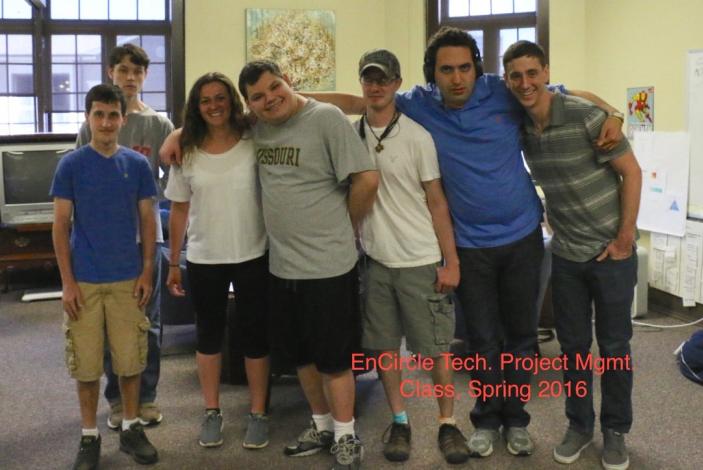
Student teaches project management soft skills to adults with autism

Students pose for an end of semester photograph with their instructors. From left: Cody, Garrett, Bridget (PM Instructor), Tyler, Austin, Nic and Peter (IT Instructor).
In spring 2016, MU management student Bridget Allgier took on the role of Project Management Instructor at EnCircle Technologies, a local nonprofit organization dedicated to training adults with autism for jobs in technology related fields. EnCircle students provide services related to website design and software.
The organization wanted their students to learn soft skills that would enhance their ability to interact with clients and effectively complete projects. Bridget’s project was launched when Teri Walden, Executive Director of EnCircle, reached out to Management Professor J. Scott Christianson in December 2015 to ask for assistance with teaching these skills.
Having previously completed MGMT 4060 (Project Management), Bridget was familiar with traditional and Agile project-management methods and was willing to take on the task of teaching some of these skills to EnCircle's students. Bridget designed a course to teach both Agile principles and social skills that would be useful in working with customers. EnCircle Technologies plans to incorporate these skills into other technical courses and project work.
There were several challenges to be met in teaching this course:
- Teaching a class of adults with autism requires specialized skills.
- Communication barriers for students required the creation of team projects tailored to individual abilities.
- The course only met for one hour each week, limiting the content to just key principles.
- There was not a template or much research to help inform the creation of a project-management class for this audience. As a result, the short-term goals for the class changed several times based on the students' response to activities.
The semester started with students learning about the basics of project management: how a project is defined, the contraints encountered in projects, who the stakeholders are in projects, and how to conduct a stakeholder analysis. The course then concentrated on Scrum (an Agile methodology for project management).
Students learned how user stories are constructed and how to translate user stories into the technical work needed to satisfy the users' requirements. A mid-semester simulation tied together many of the concepts of Scrum. In this simulation, Professor Christianson acted as the product owner and EnCircle students constructed an office building out of Legos in three sprints.
In another course project, each student designed a business card using Moqups software. In this project, Bridget acted as a customer who was seeking employment as a chef and provided several user stories about the functionality of the business card. As a group, the students brainstormed different ways to meet the user’s requirements and reviewed their designs with the customer.
Students also worked as a team to design a moped (motorized bicycle) with five superhero characteristics incorporated in the bike. Each student’s role, duties and goals were listed on an index card to help the workflow for the group. Every student took on a role:
- Cody served as a reporter and took notes on all ideas discussed.
- Austin was the developer and drew the final design.
- Tyler was the Scrum master. He facilitated teamwork and protected the team from problems and outside interference. During this project, Tyler understood the communication challenges the group had to overcome. To deal with these barriers, students unable to speak wrote their ideas on paper and Austin read the ideas aloud to the group.
- Nick was a project coordinator who assisted in development of the test plan.
- Garrett was a designer who built a prototype that met the customer's needs and decided the best approach for design.
Together, the class completed a design that showcased their creative abilities.
Throughout the semester, Peter, the IT instructor, debriefed students one-on-one about their social skills and areas for improvement such as knowing when to speak and contribute, how to identify new ideas and not how to participate most effectively. This helped students see how their actions affect others in a social, team and relational situation.
By the end of the semester, students had learned and practiced several key skills by using Scrum and further developed their social skills and team-building abilities.